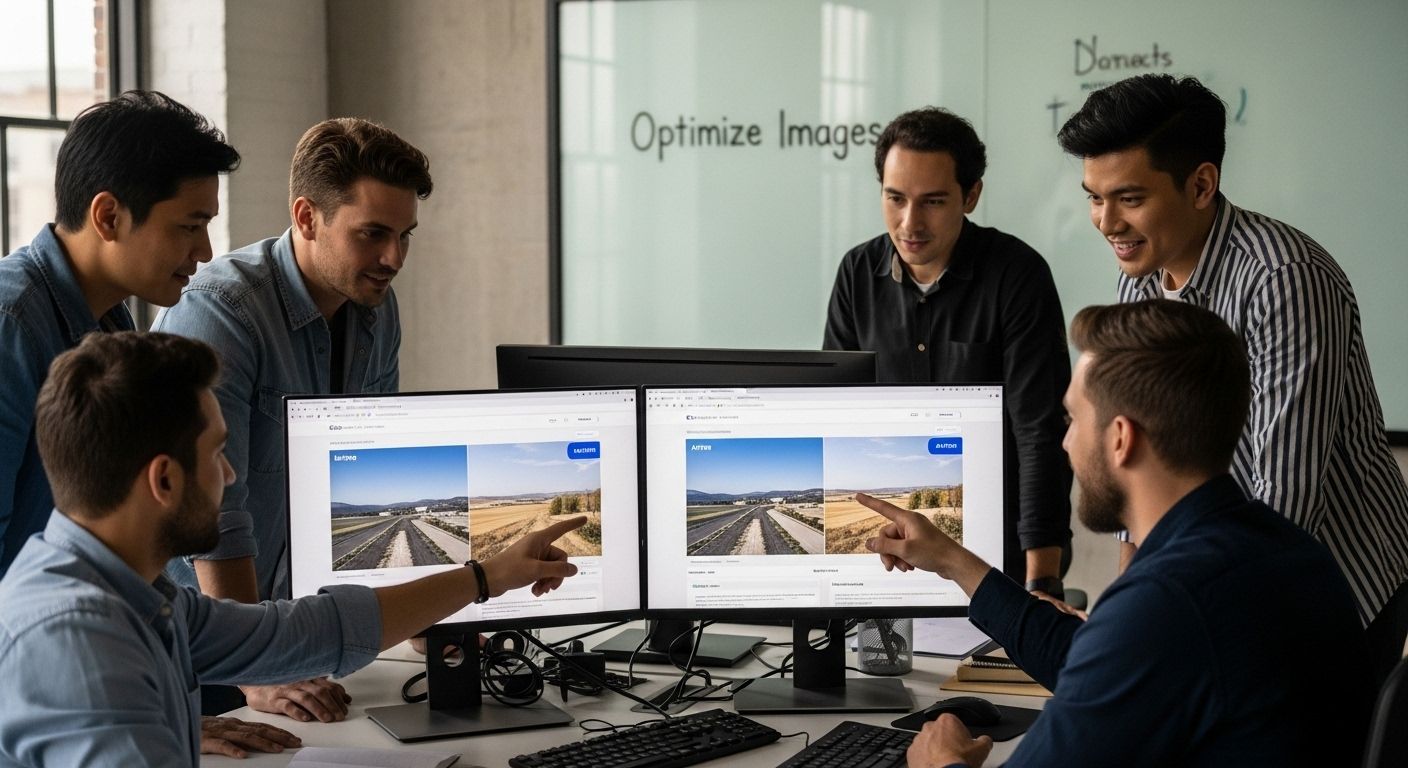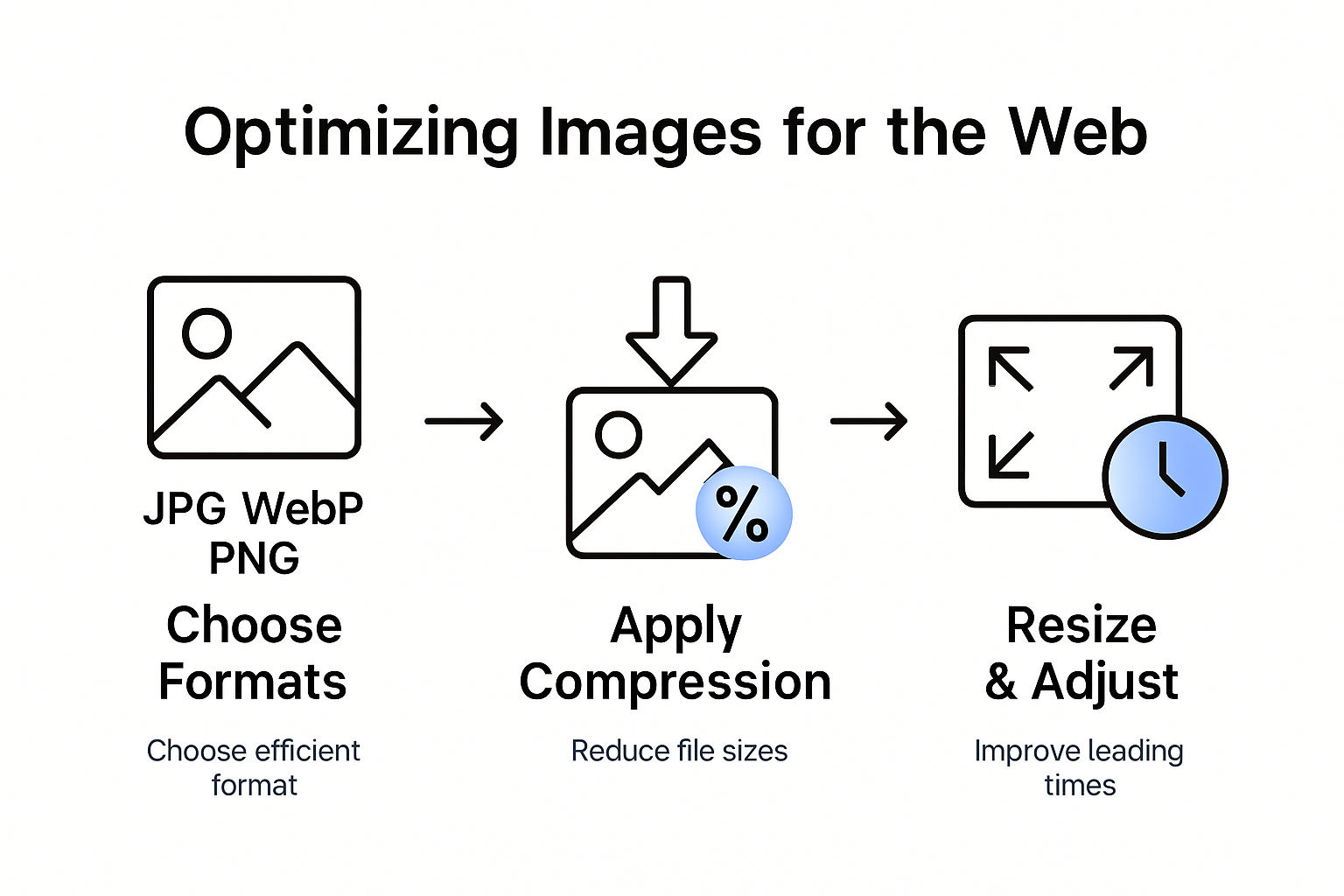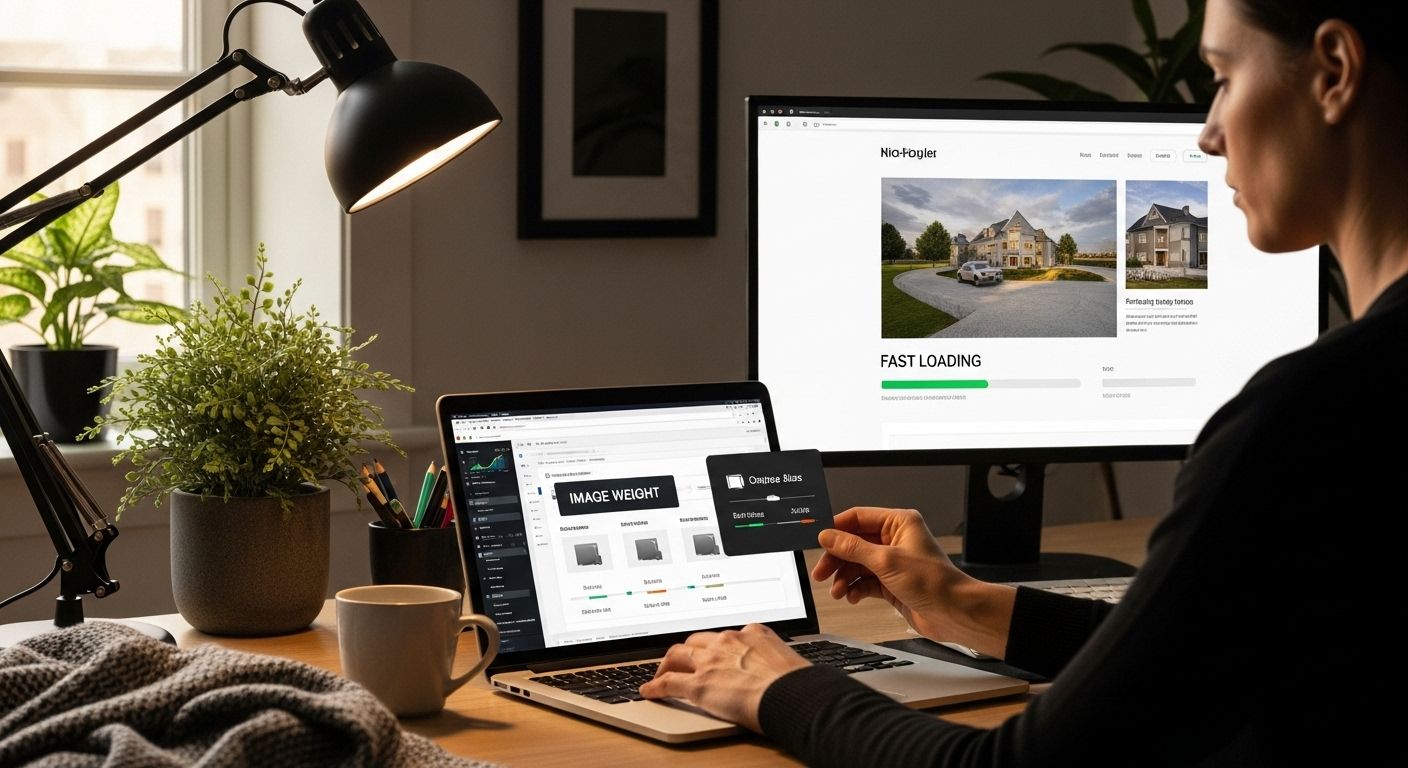How to Optimize Images for Better Website Performance


Every image on your website shapes how visitors feel about your brand and how quickly they stick around. Some sites load in a flash but others lag and frustrate users. Here is the shocker. Just one unoptimized image can slow a page by several seconds and push your bounce rate above 50 percent. That means a single oversized photo might be quietly driving away half your potential customers without you even realizing it.
Table of Contents
- Why Image Optimization Matters For Your Business
- Essential Steps To Optimize Images Effectively
- Top Tools For Image Optimization
- Common Mistakes To Avoid With Image Files
Quick Summary
| Takeaway | Explanation |
|---|---|
| Optimize images to improve speed. | Faster loading speeds enhance user experience and reduce bounce rates significantly. |
| Choose the right formats for images. | Use JPEG for photos, PNG for graphics, and WebP for better compression strategies. |
| Reduce image dimensions for efficiency. | Resize images to match display requirements, keeping them under 2000 x 2000 pixels at 72 dpi. |
| Utilize automated optimization tools. | Automated tools can compress and convert images quickly, saving time and ensuring efficiency. |
| Avoid common errors in image usage. | Prevent issues like incorrect formats and lack of responsiveness to ensure optimal website performance. |
Why Image Optimization Matters for Your Business
In the digital ecosystem, images are more than just visual decorations. They are critical performance drivers that directly impact your website's success. IEEE Computer Society emphasizes that image optimization is a strategic imperative for businesses seeking to enhance online performance and user engagement.
The Performance Impact of Unoptimized Images
Unoptimized images are silent performance killers. They dramatically slow down website loading speeds, creating a frustrating user experience that can cost you potential customers. Adobe reveals that large, uncompressed images consume significant bandwidth and increase page load times, directly correlating with higher bounce rates.
Key Performance Consequences:
- Slow Loading Speeds: Unoptimized images can increase page load times by several seconds
- Reduced User Engagement: Visitors typically abandon websites that take more than 3 seconds to load
- Negative SEO Impact: Search engines penalize slow-loading websites in rankings
Business Benefits of Strategic Image Optimization
Optimizing images is not just a technical task. It's a strategic business decision with measurable benefits. AMST highlights that proper image optimization leads to substantial improvements across multiple business metrics.
Strategic Advantages Include:
- Enhanced User Experience: Faster loading images create smoother navigation
- Improved Search Rankings: Properly optimized images contribute to better SEO performance
- Reduced Operational Costs: Smaller image files mean lower bandwidth consumption and hosting expenses
By implementing intelligent image optimization strategies, businesses can transform visual content from a potential performance bottleneck into a competitive advantage. The key lies in understanding how to balance image quality with technical efficiency, ensuring your website delivers a fast, engaging, and visually compelling experience for every visitor.
Essential Steps to Optimize Images Effectively
Effective image optimization requires a strategic approach that balances technical precision with visual quality. Digital.gov highlights that images often consume the majority of downloaded bytes on a webpage, making their optimization critical for performance.
Choosing the Right Image Format and Compression
Selecting the appropriate image format is the first crucial step in optimization. IEEE Computer Society recommends specific formats based on image type: JPEG for photographs, PNG for graphics with transparency, and emerging formats like WebP for superior compression.
Here is a summary table comparing recommended image formats and their best use cases for optimization, as discussed above. This will help you quickly choose the most appropriate format for your website images.
| Image Format | Best Use Case | Key Features |
|---|---|---|
| JPEG | Photographs | Good compression, lossy, small files |
| PNG | Graphics with transparency | Lossless, transparency support |
| WebP | All images (if supported) | Superior compression, supports transparency and animation |
| AVIF | All images (if supported) | Next-generation format, high compression, efficient |
Compression Strategies:
- Lossy Compression: Reduce file size by eliminating some image data while maintaining visual quality
- Lossless Compression: Preserve all original image details while reducing file size
- Progressive Loading: Implement techniques that allow images to load gradually, improving perceived performance
Resize and Optimize Image Dimensions
Columbia University provides clear guidelines for image sizing. Keeping images lean involves carefully managing their dimensions and resolution. Recommended practices include:Optimization Techniques:
- Resolution Limit: Maintain images at 72 dpi for web use
- Maximum Dimensions: Restrict image size to 2000 x 2000 pixels
- Contextual Sizing: Resize images to match their display requirements precisely
Additionally, implementing descriptive alt text not only enhances accessibility but also provides SEO benefits. Each image should tell a story, even when it cannot be visually displayed.
By meticulously applying these optimization techniques, businesses can significantly improve website performance, reduce bandwidth consumption, and create a smoother user experience. The goal is not just to reduce file size, but to maintain visual quality while ensuring rapid, seamless image loading across all devices and network conditions.

Top Tools for Image Optimization
Optimizing images requires powerful yet user-friendly tools that can transform visual content efficiently. Google web.dev offers comprehensive guidance on selecting and utilizing top-tier image optimization tools that can dramatically improve website performance.
Desktop and Online Compression Tools
Professional image optimization demands versatile tools that balance quality and file size reduction. Google PageSpeed Insights recommends several robust solutions for different skill levels and requirements.
Recommended Desktop Tools:
- ImageMagick: Powerful command-line tool for batch image processing
- GIMP: Open-source image editing software with advanced compression capabilities
- Squoosh: Web-based tool for precise image compression and format conversion
Automated Image Optimization Solutions
Automation is key for businesses managing large volumes of visual content. Modern optimization tools offer intelligent features that streamline the image compression process without manual intervention.
Automated Optimization Features:
- Bulk Processing: Tools that can compress multiple images simultaneously
- Format Conversion: Automatic transformation to next-generation formats like WebP
- Build Process Integration: Optimization tools that work directly within development workflows
Choosing the right image optimization tool depends on your specific needs. Whether you're a developer seeking command-line efficiency or a content creator wanting user-friendly interfaces, there are solutions designed to simplify your image optimization process. The goal remains consistent: reduce file size, maintain visual quality, and enhance website performance.
By leveraging these sophisticated tools, businesses can ensure their visual content loads quickly, looks professional, and provides an optimal user experience across all devices and network conditions.
Common Mistakes to Avoid With Image Files
Image optimization requires precision and strategic thinking. Google Web Fundamentals reveals that seemingly minor mistakes can dramatically impact website performance and user experience.
Incorrect Image Formatting and Resolution
Choosing the wrong image format or resolution is a critical error that can compromise your website's performance. Web.dev emphasizes the importance of selecting appropriate image formats and resolutions for different contexts.
Formatting Mistakes to Avoid:
- Uncompressed Image Uploads: Uploading high-resolution images without compression
- Incorrect File Formats: Using JPG for graphics or PNG for photographs
- Ignoring Next-Generation Formats: Failing to leverage WebP or AVIF formats
Neglecting Image Responsiveness and Performance
Modern websites require images that adapt seamlessly across different devices and screen sizes. Overlooking responsive design principles can lead to significant user experience problems.
To help you avoid common pitfalls, the table below summarizes frequent image optimization mistakes mentioned in this section, along with a brief description of each issue.
| Mistake | Description |
|---|---|
| Uncompressed Image Uploads | Uploading high-resolution files without compression |
| Incorrect File Formats | Using JPG for graphics or PNG for photographs |
| Ignoring Next-Generation Formats | Not leveraging WebP or AVIF formats |
| No Image Dimension Specifications | Failing to define width and height for images |
| Lack of Responsive Image Techniques | Not using srcset or picture elements |
| Excessive Image Weight | Using unnecessarily large files |
Performance Pitfalls:
- No Image Dimension Specifications: Failing to define image width and height
- Lack of Responsive Image Techniques: Not using srcset or picture elements
- Excessive Image Weight: Uploading unnecessarily large image files
By understanding and avoiding these common mistakes, businesses can create visually compelling websites that load quickly and provide a smooth user experience. The key is to be intentional about image selection, formatting, and optimization.

Remember that image optimization is not just about reducing file size. It is about delivering the right visual content in the most efficient manner possible. Strategic image management can significantly improve website performance, user engagement, and ultimately, your digital success.
Frequently Asked Questions
How can unoptimized images affect my website's performance?
Unoptimized images can slow down website loading speeds significantly, leading to higher bounce rates and a negative user experience. Just one oversized image can delay a page's load time by several seconds.
What are the best image formats for web optimization?
The best image formats for web optimization include JPEG for photographs, PNG for graphics with transparency, and WebP for better compression strategies, providing high-quality images with smaller file sizes.
What tools can I use for image optimization?
For image optimization, you can use tools like ImageMagick for batch processing, GIMP for advanced editing, or online tools like Squoosh for precise image compression and format conversion. Automated solutions are also available for larger volumes of images.
How do I properly resize images for my website?
To properly resize images, keep the maximum dimensions under 2000 x 2000 pixels and ensure the resolution is set to 72 dpi for web use. This helps maintain image quality while reducing file size.
Ready to Boost Your Website's Speed and Visibility?
If you have struggled with slow site speeds or high bounce rates due to heavy images, you know the frustration of seeing potential customers leave before experiencing your brand. The article you just explored highlights how unoptimized images can sabotage both user experience and search rankings. You work too hard on your business to let issues like sluggish performance or lackluster SEO hold you back.

Babylovegrowth.ai lifts that weight off your shoulders. Our all-in-one AI platform generates fully optimized content and automates the SEO process from start to finish. You get a personalized 30-day plan, high-quality articles, and backlinks that help your optimized images shine in the search results. Start your free trial and capture more customers now by visiting Babylovegrowth.ai. Need proof that our SEO strategies deliver real results? Check out our success stories and take the first step toward seamless growth. Do not let slow images stall your growth when a smarter solution is one click away.
Smart SEO,
Faster Growth!
Most Read Articles

Generative Engine Optimization (GEO)
Learn how Generative Engine Optimization (GEO) helps your content rank in AI search engines like ChatGPT and Google AI. This comprehensive guide explains the differences between SEO and GEO, why it matters for your business, and practical steps to implement GEO strategies for better visibility in AI-generated responses.

Track LLM Traffic in Google Analytics 4 (GA4)
Learn how to track and analyze traffic from AI sources like ChatGPT, Claude, Perplexity, and Google Gemini in Google Analytics 4. This step-by-step guide shows you how to set up custom filters to monitor AI-driven traffic and make data-driven decisions for your content strategy.

How to Humanize AI Text with Instructions
Learn practical techniques to make AI-generated content sound more natural and human. This guide covers active voice, direct addressing, concise writing, and other proven strategies to transform robotic text into engaging content.

Open AI Revenue and Statistics (2024)
Comprehensive analysis of OpenAI financial performance, user engagement, and market position in 2023. Discover key statistics including $20B valuation, $1B projected revenue, and 100M+ monthly active users.